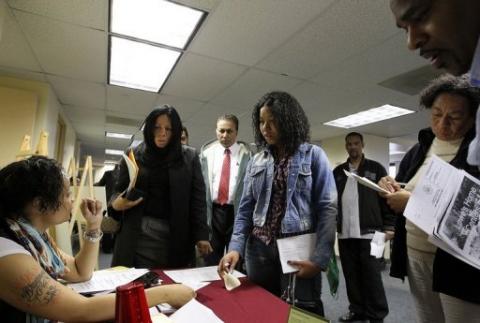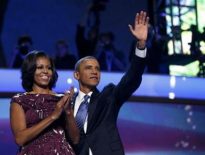Fresh figures on the US jobs market come out Friday, with a lot more than usual riding on them: new stimulus from Federal Reserve, and the poll numbers for President Barack Obama as he fights to keep his job.

With the employment situation stagnant this year — the jobless rate is stuck at a high 8.3 percent — the new data for August could say a lot about the strength of the economy, as it weathers a global downturn and a domestic stalemate on economic policy.
Chances are, economists say, the numbers will fall in the tepid range of July. The 163,000 net jobs created in July was more than double the average for a dismal April-June, giving some hope for a rebound.
But in fact it was barely above the average of 2011-2012, and far below the 200,000-plus level of December-February, when confidence was running high.
“At this point in the economic cycle, the economy should be generating over 250,000 new jobs each month,” pointed out Fred Dickson at DA Davidson & Co.
Analysts are predicting 130,000 new jobs, slightly below average for the year, with the jobless rate hanging at 8.3 percent. That would serve as confirmation that the economy has modest strength, but not enough to have a rapid and lasting impact on overall unemployment.
The numbers come two months before voters go to the polls in a presidential election seen as a referendum on Obama’s economic stewardship, especially whether he could have done better pulling the country out of recession.
Republican challenger Mitt Romney argues that the high level of officially unemployed as well as labor force dropouts, more than 19 million Americans combined, is evidence that Obama has failed.
“I don’t recall a time when these jobs numbers… were as politically significant as they’ll be this Friday,” said Robert Reich, US secretary of labor in the 1990s and now a professor at University of California at Berkeley.
If the trend is good — if the rate of unemployment drops and the number of payroll jobs is as good if not better than it was in July — President Obama’s claim we’re on the right track gains crucial credibility.
“But if these numbers are moving in the wrong direction, Romney’s claim the nation needs a new start may appear more credible.”
The data will also set the tone for monetary policy, ahead of the September 12-13 meeting of the Federal Reserve’s policy board, the Federal Open Market Committee.
Last week Fed chief Ben Bernanke laid out his case for the FOMC to take more action to boost the economy, citing the lack of progress this year on jobs and the rise in long-term joblessness.
“The economic situation is obviously far from satisfactory,” he said at the Fed’s annual conference of central bankers in Jackson Hole, Wyoming.
“The stagnation of the labor market in particular is a grave concern not only because of the enormous suffering and waste of human talent it entails, but also because persistently high levels of unemployment will wreak structural damage on our economy that could last for many years,” he said.
Bernanke’s argument for Fed action hinged on his seeing too little that was positive in the flow of data that make up the pieces of the US economy puzzle.
The recent numbers remain mixed. Auto sales were strong in August, but the manufacturing sector showed a third straight monthly contraction last month, according to the Institute for Supply Management’s purchasing managers survey.
But on Thursday the ISM index for the much larger services sector showed a pickup in the pace of growth, and two other indicators — the weekly new claims for unemployment insurance and a private-sector layoffs measurement — were also better than expected.
“Based on the tone of the minutes of the last Fed meeting, as well as Chairman Bernanke’s Jackson Hole speech, we sense that policymakers are inclined to do something to further ease monetary policy — but the employment data could influence specifically which measures are adopted,” said Joseph LaVorgna of Deutsche Bank.
Middling numbers, around 150,000 new jobs, would likely see the Fed opting to be more aggressive in its verbal signals of keeping its easy money policies in place for the medium term.
“If there is a sharp negative surprise from the employment figures, say payrolls come in below 75,000 and the unemployment rate rises a couple of tenths, then the Fed would undertake QE (quantitative easing) in addition to our expected language changes,” LaVorgna said.





